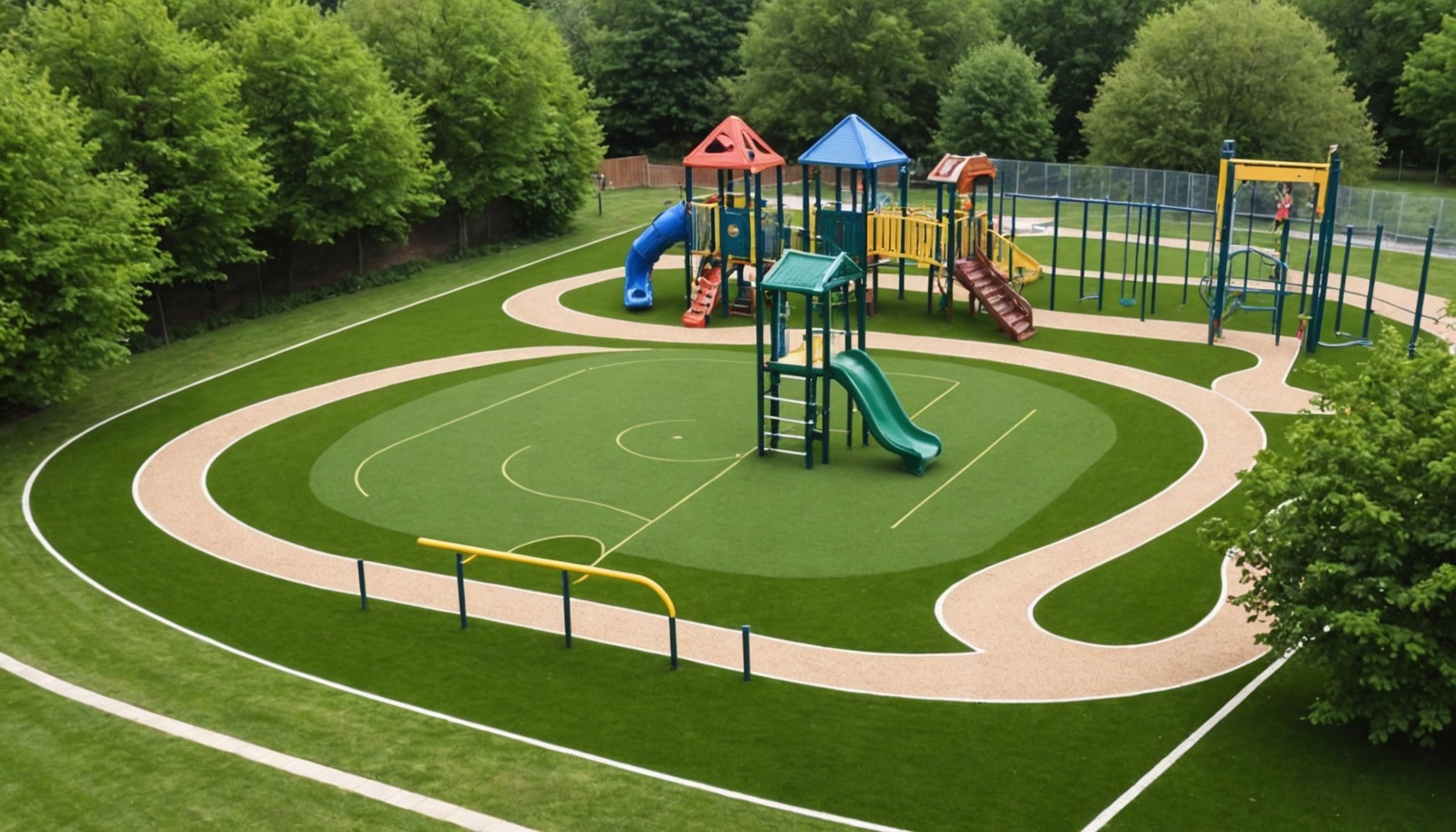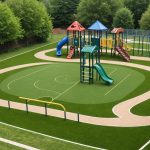Overview of Eco-Friendly Playground Design
Eco-friendly playgrounds focus on reducing environmental impact while providing quality play spaces. These playgrounds incorporate sustainable design principles that are increasingly popular in UK sports venues. Designed to balance play, safety, and environmental stewardship, they are essential in combating the detrimental effects of traditional playgrounds on the ecosystem.
Recent trends in sustainable design for sports venues emphasize the integration of eco-friendly materials and renewable energy solutions. This shift is crucial because conventional playgrounds often rely on plastics and non-renewable resources, which contribute to pollution and habitat destruction.
Also to read : Tackling Climate Hurdles: Key Tactics for UK Sports Teams Gear Up for International Contests
The importance of eco-friendly playgrounds extends beyond environmental benefits. They promote social responsibility and enhance community engagement by fostering spaces that are inclusive and accessible for all. This move towards sustainability aligns with broader green initiatives seen across various sectors.
Key initiatives include using recycled materials and incorporating native flora, reducing the need for synthetic fertilizers and pesticides. Additionally, water conservation techniques like rainwater harvesting are increasingly adopted, reflecting a more comprehensive approach to sustainability.
Also to discover : Mastering Squash: How UK Players are Using Tech to Perfect Their Shots
Eco-friendly playgrounds are not just a trend but a necessary evolution towards a more sustainable future for recreational spaces in the UK and beyond.
Innovative Strategies for Sustainable Playground Implementation
To enhance playground design sustainability, incorporating natural elements and biodiversity is paramount. By integrating local flora and fauna, playgrounds become vibrant, living ecosystems. These elements provide children with educational opportunities, promoting a deeper connection to nature. Additionally, the use of recycled and sustainable materials is a proven strategy. Materials such as reclaimed wood or recycled plastics offer durability and environmental benefits. They reduce waste and lessen the demand for new resources, thereby supporting the climate.
Minimizing the environmental footprint involves strategic design techniques. For example, orienting playground equipment to utilize natural shading can decrease the need for artificial cooling solutions. This not only saves energy but also creates a more comfortable play environment. Furthermore, implementing permeable surfaces can manage water runoff efficiently, supporting local water conservation efforts.
An effective strategy is the adoption of eco-friendly construction practices. This includes using local materials to cut transportation emissions and employing renewable energy sources during construction. Creating a sustainable playground requires innovative thought and commitment to reducing environmental impacts. Simple acts such as reducing emissions and effective resource management drastically influence the ecological balance and longevity of playgrounds.
Case Studies of Successful Eco-Friendly Playgrounds in the UK
The UK has witnessed several successful implementations of eco-friendly playgrounds that highlight effective strategies in sustainable design. These case studies demonstrate how creativity and commitment to environmental goals can lead to remarkable transformations in playground infrastructure.
Examples of high-profile sustainable playground projects
One notable example is London’s Tumbling Bay Playground. This space integrates natural elements, using materials like reclaimed wood, to create a visually appealing and ecologically responsible play area. The blend of diverse plant species contributes to local biodiversity, providing children with an immersive nature experience.
Lessons learned from failures and successes
Learning from past attempts, including challenges faced in using certain materials, is crucial. Some projects struggled with durability issues when implementing new materials without proper testing. However, those who overcame these difficulties employed sustainable resources wisely, enhancing both safety and environmental performance over time.
Community engagement and feedback in design processes
Such case studies also underscore how crucial community engagement is in the design process. Active participation from local residents in planning stages ensures playgrounds meet specific community needs, resulting in spaces that are both loved and well-used. Residents often provide valuable feedback on design preferences and success measures, making collaborative approach a cornerstone of effective eco-friendly playground implementations.
Benefits of Sustainability in Sports Venues
The sustainability benefits in sports venues offer multiple advantages beyond just environmental preservation. By adopting sustainable practices, communities see improved health and well-being. Green spaces and eco-friendly environments positively influence both mental and physical health, reducing stress and encouraging active lifestyles. Moreover, these venues demonstrate economic gains through reduced operational costs. Implementing energy-efficient systems and sustainable resources leads to significant savings, potentially freeing up funds for other community programs.
In addition to financial perks, eco-friendly initiatives enhance the visitor experience by creating more inviting and enjoyable environments. Venues utilizing renewable energy and sustainable infrastructure often provide cleaner air and more comfortable temperatures. The emphasis on sustainability doesn’t just benefit the environment but also fosters a sense of social responsibility and community engagement.
Further, many venues receive increased funding and support from eco-conscious investors and organisations prioritising sustainable development. The combination of economic, health, and environmental benefits make sustainability not just a responsible choice, but a compelling necessity for future development in the sports and recreation sectors. Therefore, integrating sustainable practices ensures long-term viability and enhances overall performance.
Materials and Technologies for Eco-Friendly Playgrounds
The shift towards eco-friendly playgrounds has brought attention to sustainable materials and advanced technologies. Using eco-conscious materials like recycled plastics, reclaimed wood, and bamboo significantly reduces environmental footprints. These materials, known for their durability, are ideal for creating safe and resilient playground equipment. Recycled plastics, for instance, prevent waste by reusing existing resources, while reclaimed wood lends a natural aesthetic to the play area.
Embracing emerging technologies also facilitates more ecological designs. Solar panels can be incorporated to power lighting or interactive play features, embracing renewable energy usage. Additionally, smart irrigation systems use moisture sensors to optimise water usage for greenery. This innovation conserves water by ensuring plants receive adequate hydration only when necessary.
Maintenance of these materials is vital for long-term sustainability. Eco-friendly playgrounds demand regular inspections to identify wear and ensure safety. Advanced materials generally require less routine upkeep than their traditional counterparts, prolonging their lifespan and maintaining performance standards. Moreover, understanding material-specific care techniques helps in preserving their integrity.
Together, sustainable materials and technologies support the overarching goals of eco-friendly playgrounds, providing vibrant and safe environments while prioritising environmental stewardship.
Best Practices for Maintaining Performance Standards
Ensuring performance standards in eco-friendly playgrounds requires attention to both sustainability and usability. A key strategy involves balancing athletic performance with environmental responsibility. Playgrounds should provide adequate support and flexibility to encourage physical activity while minimizing ecological footprints.
Routine maintenance and inspection protocols are crucial for sustaining performance and safety. Eco-friendly materials, while durable, can still suffer wear and tear. Regular checks ensure equipment remains safe and operational, preventing injuries and maintaining user satisfaction.
Training staff on eco-friendly practices is vital. By educating personnel on sustainable procedures, such as energy-efficient operations and resource conservation, playgrounds can optimize their environmental impact. Staff should also be equipped to educate visitors about the sustainability initiatives in place, fostering a community of informed and environmentally conscious users.
Implementing these best practices not only enhances performance but ensures long-term sustainability, aligning with broader ecological objectives. By integrating these methods, playgrounds can remain vibrant, safe, and enjoyable for all, reflecting a commitment to both quality and environmental stewardship.






